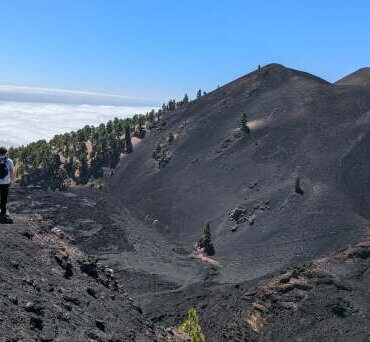
1949 San Juan eruption in the island of La Palma
This week I have been driving across the island of Tenerife through a heatwave, for a project on volcanic resilience in the town of Garachico. The idyllic seaside town was devastated by an eruption in 1706. Lava flows changed the economy of the island by partly filling in the important port.

Janine Krippner
The Trevejo cone is now located far up the flanks above us, above sheer cliffs of exposed lava flows that construct most of Tenerife. The narrow roads are harrowing, with stunning views across the Atlantic Ocean, with a glance down the plunging cliffside making one grateful for the short concrete barriers.
The other aspect that stands out is the gorgeous colourful stone buildings with wooden balconies between beautiful old churches and town halls. They are built across steep volcanic flanks and old lava deltas – where lava flows have created new land out into the sea.
Looking up at the cliffs, then down at the communities, I voice out loud to my colleague Javi Diaz Cabrera (who was thankfully driving like a pro) that this would be a mess if a large earthquake struck the area. Javi is a local, from the neighbouring island of Gran Canaria, and this week he defended his Master’s project on earthquake damage scenarios on Granada in mainland Spain.

1909 Chinyero eruption in the island of Tenerife
Mainland Spain is an area of moderate seismic risk, so damage to infrastructure is an important topic. In order to prepare, we have to understand what might happen. The first step is understanding what the earthquakes might look like, then how the ground (soil and rock) may behave with the shaking.
The buildings themselves are an important part of the equation. In Spain there is a variety of older large block homes, some made of dirt, all the way to newer reinforced concrete buildings and some steel structures. You would be hard-pressed to find a wooden home he has not studied.
His results show that during a moderate-intensity earthquake, many buildings will experience cracks through the walls, and the orange ceramic roof tiles may fall. As we learned in Christchurch, this is a danger to those in the streets. The highest amount of damage is expected to occur in the beautiful downtown historical centres.
For a higher intensity scenario, the footings or piles that are built into the ground may crack and result in structural failures. In this case, most of the historical centres and more modern areas could experience severe damage, requiring a rebuild.
This then leads to the social questions of how we help people who are evacuated for an extended period. We have seen how destructive earthquakes in Aotearoa are. The challenges in these older European countries can look quite different. It takes just one tile to end a life as someone runs out of a building.
While Tenerife may not have the higher intensity tectonic earthquakes of mainland Spain, through my own work I have read about how intense precursory seismicity prior to an eruption can be here. The path to preparedness is complex and long, with each step along the way hopefully leading to more resilient communities.

1949 San Juan eruption in the island of La Palma








